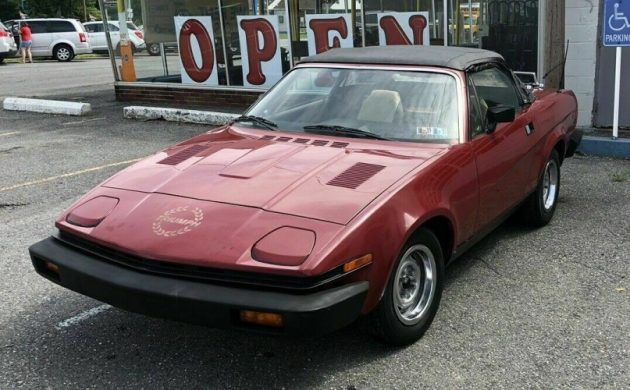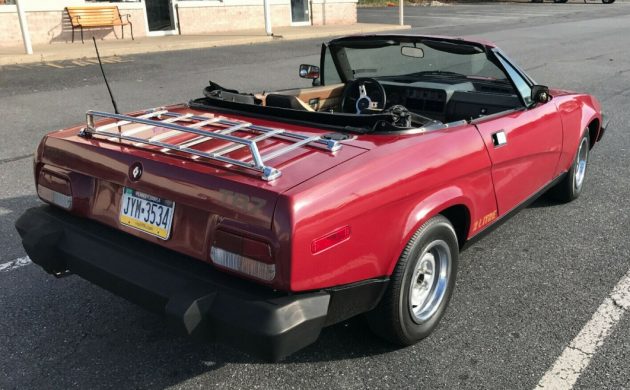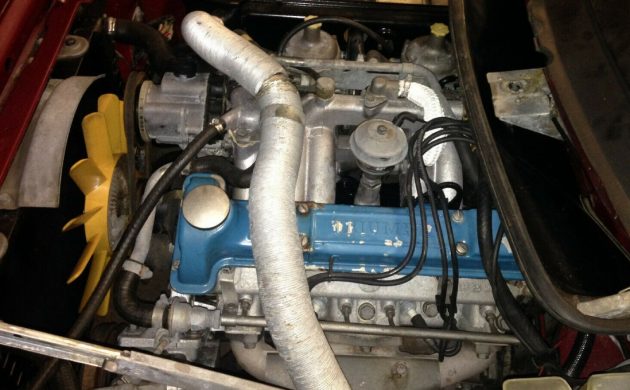The Triumph TR7 is a car that I find interesting because it was never intended to be released in convertible form. When the company finally yielded to buyer demand and followed that path, the resulting car turned out to be far more attractive than the Coupe on which it was based. This 1980 TR7 Drophead is a fairly attractive looking car that appears to be in better than average condition. It is located in Bethlehem, Pennsylvania, and is listed for sale here on eBay. The owner has set the listing to open at $3,750, but there have been no bids to this point. There is also a BIN option available, and this has been set at $4,875.
It appears that this particular TR7 is a 30th Anniversary Edition, but it is missing a few of the distinctive features that were part of the package. It has the correct “2 Litre” decals on the rear quarter panels, and the wheels are correct (although missing their center caps). The luggage rack is also present, but the side pinstripe and fog-lights are both absent. As the majority of these items were dealer-fitted, it is entirely possible that the original owner might have chosen to delete the pinstripe and fog-lights. The center caps for the wheels might pose a bit of an issue if the owner wants to ensure authenticity for the car. These were specific to the 30th Anniversary cars, so finding replacements might be a bit of a battle. Finished in Carnelian Red, you can see how well the TR7’s styling suited being produced as a convertible. The upper body lines flow nicely from the nose of the car, all the way to the tail. One of the things I like about the TR7 finished in this shade is that it makes that often criticized crease along the side of the car far less prominent and obvious. The paint on this TR7 doesn’t look to be in bad condition, and it is said to be original. It does show a few chips and marks, but it is a 39-year-old car, so this is to be expected. One reassuring aspect of this particular Triumph is that it doesn’t appear to have any rust issues. The TR7 could be prone to this, but if it has survived for this long, this is a pretty good sign.
Inside the Triumph looks to be largely original, and also in pretty good condition. Under those aftermarket seat covers, the Tan Check (that’s its official name) upholstery looks to be in quite good condition, and while the 30th Anniversary package brought an AM/FM radio/cassette player to the party, the one fitted to this car isn’t original. However, it does wear the correct plaque on the glove compartment lid, along with the correct steering wheel. Overall, the interior looks to be in above average condition and will need virtually no restoration work.
Powering the TR7 is the 1,998cc 4-cylinder engine, which was based on the engine from the Triumph Dolomite. This sends its 88hp to the rear wheels via a 5-speed manual transmission. The engine in the TR7 has only accrued around 5,000 miles since it underwent a complete rebuild, and the owner holds all of the documentation to verify the work. The TR7 is by no means a high-performance car, but it is still a respectable performer nonetheless. It could accelerate from 0-60mph in a shade over 10 seconds, which is reasonable going for a car with such a low horsepower figure. While the owner doesn’t mention how well the car runs and drives, the low mileage since the rebuild, coupled with the neat and clean presentation of the engine bay, does give us cause for optimism.
When Triumph finally relented in 1979 and released the TR7 Drophead, the impact on sales was almost instantaneous, and also quite profound. In 1980, Triumph produced a total of 88 Coupes for the export market (including the USA). Dropheads accounted for 6,199 cars, which really reflected the pent-up demand for such a car. By the following year, this figure had dropped to a mere 1,421 cars as the production of the TR7 eventually ceased. The survival rates for these cars has not been particularly great, and this was due in a large part to the rust issues that I mentioned earlier. However, if a TR7 has survived up until this point with no rust issues, then it wouldn’t be a bad little British sports car to own. This looks like one of those cars, and the fact that it is a 30th Anniversary Edition is just a bit of a bonus.





I think that is a later Moto Lita wheel and not what I have seen on these. The correct wheel had 9 attachment screws to the boss, solid spokes and less dish. Looks like a really nice example, a worth a look.
You are correct about the steering wheel. I have an original wheel in the next room of my house that I pulled off a ’79 TR7 Spider and I just went in and checked– solid spokes.
I would love to test drive a well-sorted one of these, or even better, a 1980 TR8 with the V8 engine. I had a ’76 hardtop many years ago but it was a garage queen with lots of electrical problems. I think Lucas the British Prince of Darkness for all things electrical was as big a culprit as rust for the demise of the TR7.
Electrical problems were a standard feature. On the buddy’s when you hit the light switch the wipers went. on….and any time it rained it wouldn’t start.
Had a 1980 convertible in bright red. Loved it until a head gasket failure.
The aluminum head is fitted over steel studs=corrosion. The shop put penetrating oil on the studs every day for four weeks and they could only get the head up about an inch. Fortunately, at that time, I was able to buy a NOS head and had it shipped to the shop. They broke off the old head and reassembled everything with the new head. Drove it about a month and then sold her. Still liked that car..very different and a blast to drive with the top down. Got to love those quirky British cars as they will always provide you with unique memories.
My best friend bought one of the first 75 TR7’s delivered in the Philadelphia/South Jersey area. It was a funny shade of dark blue, and I thought it was just about the ugliest car I’d ever seen. Strangely enough, when Triumph decided to cut the roof off of the TR7, a couple years later, I fell in love with the look of these things.
I was at Watkins Glen in July 79, when Bob Tullius showed up with the first TR8 race car, and even though I still didn’t care for the coupe body style, the large flares and absolute speed of the car, made it hard not to like it.
This is a pretty nice example of the breed, though I’d like it a lot more, without that luggage rack.
(crickets chirping) Nobody wanted them then, and not many today, as evidenced by the 0 bids. Kind of a shame, purists wanted nothing to do with it, just too far out there. Today, however, I’m surprised nobody wants this. It has everything a person would want in a 2 seat roadster. The “Wedge” was just a classic swing and a miss. Too bad Triumph went out this way.
A good friend bought a new ’77 TR7 in December of ’76 and by July of ’77 it was gone. Every imaginable thing that could go wrong did. He had to ditch it to save his sanity.
I had a roommate that bought one new in 1976. While he didn’t have the common electrical and brake issues typical on British cars, I do have to give them credit for building a pretty structurally good car. This old roommate of mine used to drink… and as a result he wrecked the car numerous times, the first time doing over $4k in damage to the front suspension, folded the right front tire under the car against a curb as he instantly became a race car driver. He wrecked it several more times until he went off the road in a ditch and managed to hit a telephone pole just behind the driver’s door, and bent the car probably a good 15 degrees, he drove it home. I went out to get the newspaper in the morning and saw the car looking like a boomerang in the driveway. He also wrecked it a few times between these two incidents. The good news is that they were all single car accidents, he never was involved with another vehicle. But, as I said, that car took a beating, a severe beating and kept coming back for more. Eventually he came to his senses and traded it in on a new Chrysler LeBaron convertible. His TR7 was apparently crossbred at the factory with the Jaguar, the cat, because that car had 9 lives for sure.
British Leyland certainly had it’s problems. The TR7 was never popular when new. Values are still soft, not like the TR-6 which was popular when new and sought after now for good examples. Just about the only car I can remember that was a huge hit for British Leyland was the XKE. This example looks good, but personally, if I had any interest in this design it would be for the TR8, and even those are still affordable.
There is a reason that there is no bids on this piece of junk. I learned my lesson on an 80 blue one. Lucas= the man who invented darkness.
Had an 80 drophead in 1985-87. I liked it. Lived in San Diego at the time. The tranny blew up in the 4th lane over on I5 in Orange county.
I believe they started designing it as a convertanle, but quicky stopped when the US Congress was thinking of banning them.
I think in a few years these largely unloved cars will become a classic. There is a pretty decent parts supply through MOSS and Victoria British. They were only offered with a roof initially because BL knew that their main market was the USA and anticipated a ban on “drop head coupes” due to safety concerns. Meeting US emissions and crash standards ruined British sports cars in my opinion. The fact that a post 75 Midget MGB or Spitfire is worth about 25% 50% less than an older car without the US modifications, I think supports this premise.
I own a 76 Midget – which I like – but “settled” on since getting a comparable round arch proved impossible unless I was willing to pony up almost double the money.
Hey look! A Saab engine ;)